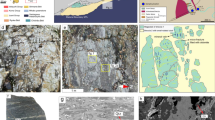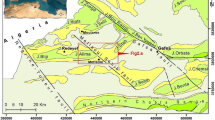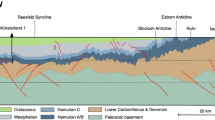Abstract
Earthquake-triggered landslides are some of the most destructive natural disasters. Although remote detection of landslides is economic and efficient, it may miss the more subtle signs of hidden landslides. The Kizawa Tunnel and facilities in its vicinity were severely damaged in the 2004 mid-Niigata Prefecture earthquake. After investigation of the most prominent cracks, the damage was attributed to the slip along a hidden weakness plane. Evidence supporting this argument is summarized in this paper. However, the extent of the shear plane is not limited to the interior of the northern part of the tunnel. The dislocation observed in the two wells to the south of the Kizawa Tunnel together with other findings from previous studies indicates that Kizawa hamlet lies on the southern extension of the same shear plane. Taking account of the presence of flat sedimentary structures, the shear plane may extend in all directions. The authors also surveyed other signs of damage along the perimeter where the shear plane intersects the ground surface. The geological and geomorphological features of the hidden landslide are discussed. Reactivation of interlayer sliding is a threat to the local residents, and thus more attention should be paid to monitoring the movement of the slope to avoid devastating damages.








Similar content being viewed by others
References
Active Fault and Earthquake Research Center (2005) The trench survey for the seismic fault in Mid-Niigata Prefecture Earthquake. Available from: http://unit.aist.go.jp/actfault-eq/katsudo/trench/niigata/index.html#point. Accessed 3 June 2010
Dadson SJ, Hovius N, Chen H, Dade WB, Lin JC, Hsu ML, Lin CW, Horng MJ, Chen TC, Milliman J, Stark CP (2004) Earthquake-triggered increase in sediment delivery from an active mountain belt. Geology 32:733–736
Deng J, Kameya H, Miyashita Y, Kuwano J, Kuwano R, Koseki J (2011) Study on a failed dip slope with a thin sandy layer in 2004 Niigata-ken Chuetsu earthquake. Eng Geol 123:302–314
Huang Y, Cheng H (2013) The impact of climate change on coastal geological disasters in southeastern China. Nat Hazards 65:377–390
Japan Meteorological Agency (2005) The Seismological and Volcanological Bulletin of Japan for October 2004. JMA, Tokyo
Japanese Society of Civil Engineering (JSCE), The Univeristy of Tokyo, Kyoto University, Waseda University, Nagaoka University of Technology, Chuo University (2006) Earthquake damage in active-folding areas: creation of a comprehensive data archive and suggestions for its application to remedial measuresfor civil-infrastructure systems (Report No. Heisei18), http://active-folding.iis.u-tokyo.ac.jp/public/18report/18report.html. Accessed 3 June 2010
Keeper DK (1984) Landslides caused by earthquakes. Geol Soc Am Bull 95(4):406–421
Kieffer DS, Jibson R, Rathje EM, Kelson K (2006) Landslides triggered by the 2004 Niigata Ken Chuetsu, Japan, earthquake. Earthq Spectra 22:47–73
Kobayashi Y (1981) Causes of fatalities in recent earthquakes in Japan. J Disaster Sci 3:15–22
Konagai K, Numada M, Zafeirakos A, Johansson J, Sadr A, Katagiri T (2005) An example of landslide-inflicted damage to tunnel in the 2004 Mid-Niigata Prefecture earthquake. Landslides 2:159–163
Konagai K, Takatsu S, Kanai T, Fujita T, Ikeda T, Johansson J (2009a) Kizawa tunnel cracked on 23 October 2004 Mid-Niigata earthquake: an example of earthquake-induced damage to tunnels in active-folding zones. Soil Dyn Earthq Eng 29:394–403
Konagai K, Fujita T, Ikeda T, Takatsu S (2009b) Tectonic deformation buildup in folded mountain terrains in the October 23rd, 2004 Mid-Niigata earthquake. Soil Dyn Earthq Eng 29:394–403
Lin GW, Chen H, Hovius N, Horng MJ, Dadson S, Meunier P, Lines M (2008) Effects of earthquake and cyclone sequencing on landsliding and fluvial sediment transfer in a mountain catchment. Earth Surf Proc Land 33:1354–1373
Mori S, Tsuchiya M (2005) Damage to Kizawa Tunnel during the 2004 Niigata-ken Chuetsu earthquake and its mechanism. J Jpn Soc Civ Eng C 28(182):1–10
Nagaoka Regional Development Bureau, Niigata Prefectural Government, Honma Corporation (2007) Construction Report of Kizawa Tunnel of the Ojiya-Kawaguchi-Yamato Line (D-16(4903-00-00-03))
Nagaoka Regional Development Bureau, Niigata Prefectural Government, Kiso-Jiban ConsultantsCo.Ltd. (2007) Investigation for rehabilitating Prefecture Road, Ojiya-Kwaguchi-Yamato Line (No. 2000-00-01-09)
Oyagi N, Uchiyama S, Inokuchi T (2008) Map of landslides caused by the 2004 Niigata-ken Chuetsu (Mid Niigata) earthquake (MJMA = 6.8). Technical Note of the National Research Institute for Earth Science and Disaster Prevention 317, Tsukuba
Suzuki Y, Watanabe M, Hirouchi D (2004) Survey reports of active faulting. (The conclusion of seismic fault survey), http://www.seis.nagoya-u.ac.jp/INFO/niigata/reportAF1024.html. Accessed 3 June 2010
Tsukuda T, Takeda T, Yanagisawa K (2008) Present-day active folding in the Ojiya Region, Niigata Prefecture, Central Japan, revealed by data from levelling measurements collected over 30 years. Bull Earthq Res Inst 83:203–215
Yanagisawa Y, Kobayashi I, Takeuchi K, Tateishi M, Chihara K, Kato H (1986) Geology of the Ojiya District. Quadrangle Series Scale 1:50,000, Niigata7(50). Geological Survey of Japan, Tsukuba
Yu B, Sun H, Shang Y, Li H (2006) Characteristics and stability analysis of Xiashan landslide in Zhejiang Province. Chin J Rock Mech Eng 25(Supp. 1):2875–2880
Zhao Y, Konagai K, Fujita T (2012) Multi-scale decomposition of co-seismic deformation from high resolution DEMs: a case study of the 2004 Mid-Niigata earthquake. Acta Geologica Sinica Engl Ed 86(4):1013–1021
Acknowledgments
The doctoral study of the first author in the University of Tokyo is financially supported by the Ministry of Education, Sports, and Culture of Japan. The authors are also grateful to Project 51208461 supported by NSFC.
Author information
Authors and Affiliations
Corresponding author
Electronic supplementary material
Below is the link to the electronic supplementary material.
12665_2014_3078_MOESM1_ESM.doc
Fig. 1 Tunnel cross-section at 59 m distance from the north portal (looking northward) (after Konagai et al. 2009a) (DOC 26 kb)
12665_2014_3078_MOESM3_ESM.doc
Fig. 3 Signs of disturbance in the mudstone layer during construction of the retaining wall in 2006 (Nagaoka Regional Development Bureau et al. 2007) (DOC 388 kb)
12665_2014_3078_MOESM4_ESM.doc
Fig. 4 Photographs of the deformed retaining wall showing a the location of the wall on an aerial photo b slight dislocation on the concrete ribs forming a retaining wall (DOC 2834 kb)
Rights and permissions
About this article
Cite this article
Zhao, Y., Konagai, K. Evidence of a hidden landslide slip surface beneath a mountain hamlet. Environ Earth Sci 71, 4615–4624 (2014). https://doi.org/10.1007/s12665-014-3078-z
Received:
Accepted:
Published:
Issue Date:
DOI: https://doi.org/10.1007/s12665-014-3078-z




